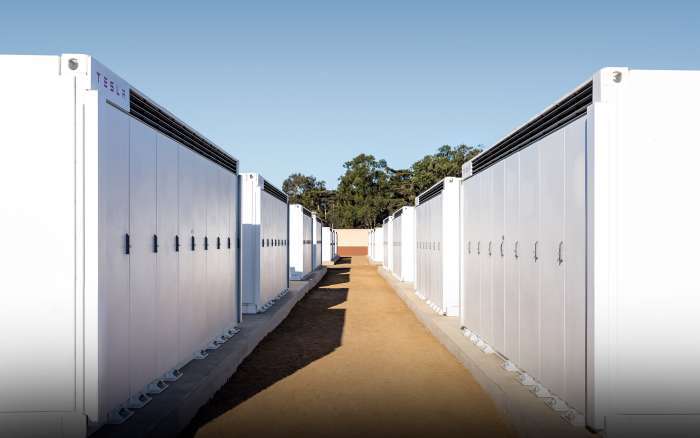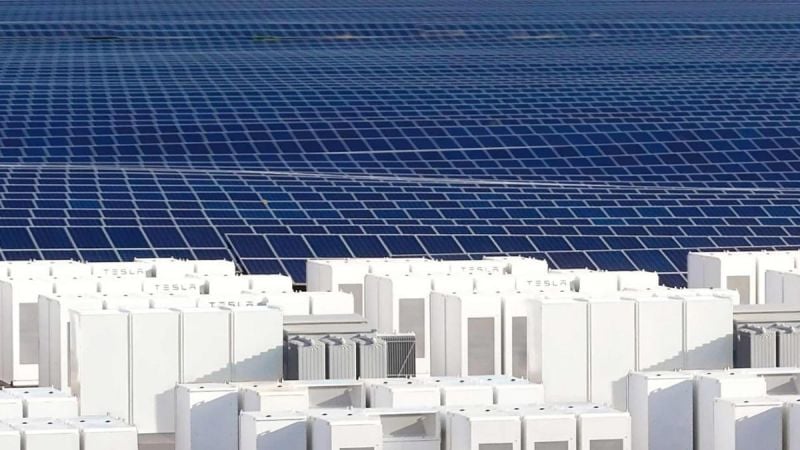And by the way, become independent from the grid by creating a series of stand-alone systems; and most importantly: to stop using highly polluting coal plants - not to mention diesel generators and other carbon-related sources of dirty energy -.
A brief description of the Tesla Megapack system: it basically transforms the way to power the grid—delivering giga-scale capacity; in their own words “… take everything we know about battery technology to enable the world's largest energy projects. A 1 Gigawatt hour (GWh) project provides record energy capacity—enough to power every home in San Francisco for 6 hours”. Every Megapack arrives pre-assembled and pre-tested in one enclosure from Tesla’s Gigafactory - including battery modules, bi-directional inverters, a thermal management system, an AC main breaker and controls, etc. No assembly is required, all you need to do is connect Megapack’s AC output to a site wiring. At the site level, Megapack requires 40% less space and 10x fewer parts than current systems on the market. As a result, this high-density, modular system can be installed 10x faster than current systems. As for applications, the key points are:
- Renewable Smoothing: smooth out the intermittency of renewables by storing and dispatching when needed;
- T&D Investment Deferral: postpone costly grid infrastructure upgrades by supplying power at a distributed location to defer the need to upgrade aging infrastructure;
- Voltage Support: inject and absorb reactive power to maintain local voltage levels on the grid;
- Capacity Support: discharge at times of peak capacity to reduce demands on distribution and transmission infrastructure;
- Microgrid: build a localized grid that can disconnect from the main power grid;
- Market Participation: provide service to the grid in response to signals sent by system operators;
- Frequency Regulation: maintain grid stability by rapidly changing charge or discharge power in response to changes in grid frequency;
- Megapack is designed for utilities and large-scale commercial customers.
A good current example is the State of New Mexico: according “CleanTechnica”, Tesla’s Megapack energy storage tech will be used to help New Mexico’s Public Service Company (PNM) to replace a retiring 562 MW coal plant, the “San Juan Generating Station”. The coal plant is located near the San Juan Mine and produced power at $45/MWh in 2018 and 2019.
Energy Storage News reported that PNM plans to procure energy from 950 MW of solar and storage facilities by next year while retiring the coal plant. PNM will lean on the Arroyo Solar and Storage Project, which is a 300 MWac solar PV plant with 150 MWac/600 MW of co-located battery storage. It has signed two separate offtake contracts for its solar and storage output and is planning to reach 100% emissions-free electricity by 2040. The article noted that the solar farm will use NEXTracker solar PV tracking technology and Sund Construction will build it. Electrical Consultands Inc will design the substation and switchyard and EPC Services company will build the infrastructure. SOLV, which is a subsidiary of both Tesla and Swinerton Renewable Energy, will perform operations and maintenance.

Another big player, Apple, signed a contract not long ago: the Cupertino company will use Tesla's Megapack battery energy storage system at its California solar farm. The company announced in April 2021 it's building one of the largest battery projects in the country, which will be capable of storing 240 megawatt-hours of energy, enough to power more than 7,000 homes for one day. The setup will include 85 of Tesla’s Megapack battery energy storage systems, which were first announced in 2019. The energy will be used to help power the company’s headquarters.
California, where Tesla was born, also has other implementations of the system:
a) Moss Landing, Tesla’s joint project with US utility Pacific Gas and Electric Company (PG&E) broke ground on the project, which will comprise 256 Megapacks, in July 2020. Megapack installation in the Moss Landing site started just two months after the groundbreaking and now it appears that most of the massive battery storage units are nearly installed. The Moss Landing Tesla Megapack site will boast a 182.5MW/730MWh battery once completed.
b) A new 142-Tesla Megapack project has been turned on in California’s Ventura County to create a giant new battery that is replacing a “gas peaker” plant. The project is called the “Saticoy battery storage system”, and it came about when the local community in Oxnard fought against having a new gas-powered peaker plant to help respond to the energy demand during peak times. Instead, they settled on a proposal from Arevon Asset Management (Arevon), a renewable energy company, to deploy a massive 100 MW/400 MWh battery system to help power the peak energy demand. The community was about to get a polluting gas power plant near the beach, and instead, they now have one of the largest energy storage sites in the US, and it was deployed in just nine months. They are using 142 Tesla Megapacks, the automaker’s largest energy storage solution.

Another example is Megapack Australia: The “Victorian Big Battery” is a 300 MW grid-scale battery storage project in Geelong, Australia, which will store enough energy in reserve to power over one million Victorian homes for 1/2 an hour. The battery has a 250 MW grid service contract with AEMO under direction from the Victorian Government. It will support Victoria’s clean energy transition and secure reliable, affordable power for Victorians, helping the state meet its renewable energy target of 50% by 2030. Neoen is working together with Tesla and network partner AusNet Services to deliver this project, which is one of the largest batteries in the world. The 300 MW/450 MWh battery will consist of 210 Tesla Megapacks covering an area smaller than the football oval at Geelong’s GMHBA Stadium in Australia.
Yet one more example is the Appalachia region in the US, encompassing the area from Mississippi-Alabama to Pennsylvania-New York: a recent study by RMI states that “… Appalachia could be the region to see the biggest economic benefit from the deployment of wind and solar projects over the next decade” (See full article: https://cleantechnica.com/2021/09/21/appalachia-poised-to-become-clean-energy-country ).
As we can see, it is no exaggeration to say that the Tesla Megapack system can help fight climate change; States, Provinces, Municipalities, or even whole countries could benefit by having a clear and focused green and sustainable policy, as they would save significant amounts of money in the first place; and relocating those savings in community-driven projects as a plus. That is not to mention the environmental, social and ethical benefits, that will be discussed in a future article.
Nico Caballero is the VP of Finance of Cogency Power, specializing in solar energy. He also holds a Diploma in Electric Cars from Delft University of Technology in the Netherlands, and enjoys doing research about Tesla and EV batteries. He can be reached at @NicoTorqueNews on Twitter. Nico covers Tesla and electric vehicle latest happenings at Torque News.













Comments
These are great for the power
Permalink
These are great for the power companies and the earth as a whole (if you remove the battery production from the equation), but back in consumer-land these huge projects take away from the ability to get reasonably-priced systems for our own needs. And while energy prices certainly won't come down because of the need to pay off these huge projects, it may be more reliable if there aren't localized disruptions. The grid is still the grid and a tree or ice storm can still stop power from being distributed to thousands of homes -- for an extended period of time. We need lots of subsidized installations of home-based solar and battery backup to make a difference in people's lives. Focusing on distributed power generation by the end user (our homes) will also allow distributed charging of these centralized storage systems, further reducing the need for supplemental power generation from large power plants.